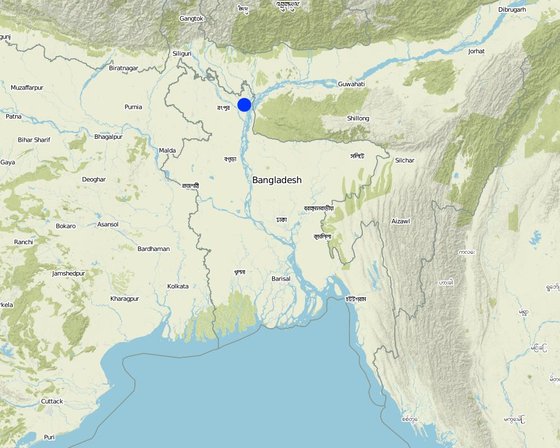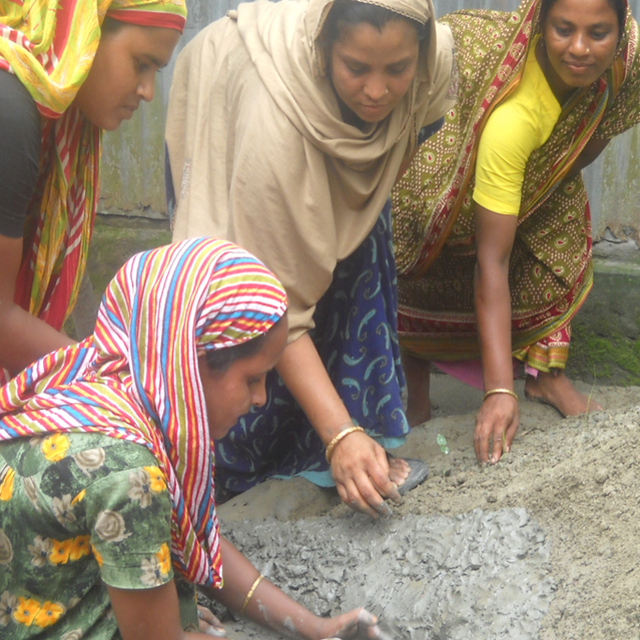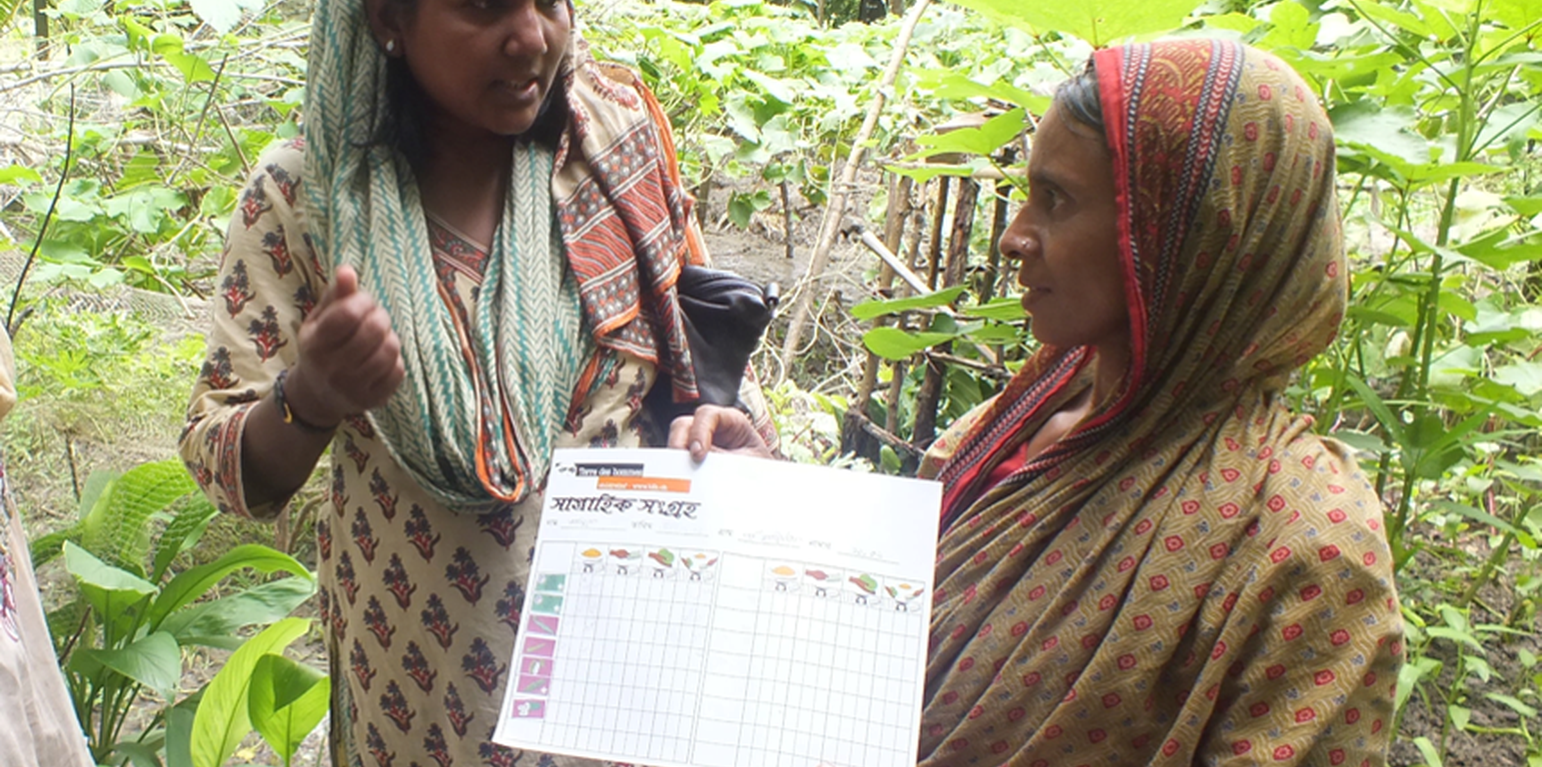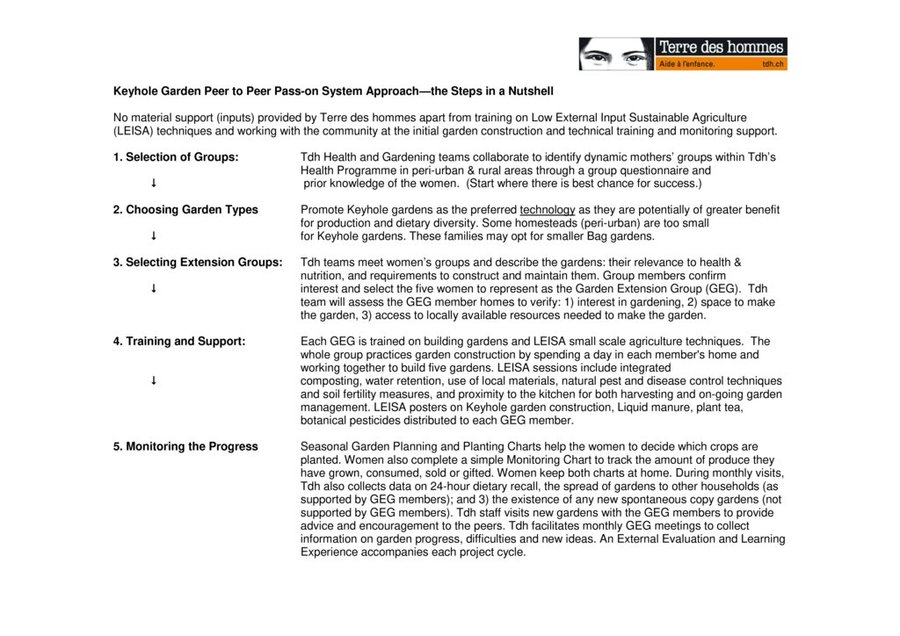Peer to Peer Pass-on Approach with Women
(บังกลาเทศ)
คำอธิบาย
Terre des hommes and Greendots introduced the Peer to Peer pass-on system to enable women's groups in Bangladesh to spread the Keyhole Garden technique within their communities with the aim of enabling year-round homestead vegetable production despite the risk of flooding and tidal surge.
Keyhole Gardens, a type of small, productive homestead vegetable garden based on Low External Input Sustainable Agriculture (LEISA) techniques, have been used in various African countries for over 15 years and shown to increase the availability of food and dietary diversity (FAO). They were developed by gardeners and small-scale farmers (with the support of Send a Cow UK) to suit different situations, such as the cold, dry winters of Lesotho, the small backyards of Rwanda, and the humid heat of central Uganda. To improve year-round homestead nutritional self-sufficiency for vulnerable families in South Asia (where rates of acute malnutrition in young children regularly cross emergency thresholds), Keyhole gardens were adapted by Terre des hommes (Tdh) and Greendots to the conditions of river basin and coastal areas of Bangladesh (and eventually to India's Sundarbuns) . As a component to Tdh's maternal neonatal and child health (MNCH) programme, the technology is intended to support year-round homestead gardening despite weather extremes (flooding, tidal surge, cyclones).
To promote spontaneous replication of the Keyhole gardening in the local communities, the programme initiated a Peer to Peer Pass-on system within 40 mothers' groups (having a total membership of nearly 800 women). Each mothers' group selected five representatives (200 women) to form a Garden Extension Group (GEG) and participate in the first round of training with the understanding that they would share knowledge with other women in the MNCH programme and the surrounding community. The project team trained each GEG on building gardens and LEISA small scale agriculture techniques (including integrated composting, water retention, use of local materials, natural pest and disease control techniques and soil fertility measures, proximity to the kitchen for optimal management and harvesting). GEG group members practiced garden construction by working together to build gardens at the homes of all five members. All 200 initial gardens were monitored by Tdh extension workers on a weekly basis. Tdh verified output, use and the capacity of gardens to withstand monsoon conditions, and the extent of the of the Peer to Peer Pass-on experience.
See the Chart in Section 3.3 for more information.
สถานที่

สถานที่: Kurigram municipality (Kurigram District), Patharghata Union (Barguna District), Kurigram District / Rajshahi Division and Barguna District / Barisal Division, บังกลาเทศ
ตำแหน่งทางภูมิศาสตร์ของสถานที่ที่ถูกเลือ
วันที่ริเริ่ม: 2012
ปีที่สิ้นสุด: n.a.
ประเภทของแนวทาง
-
แบบดั้งเดิม/ แบบพื้นเมิอง
-
เป็นนวัตกรรมท้องถิ่นล่าสุด/ นวัตกรรมใหม่
-
ใช้โครงงานหรือแผนงานเป็นฐาน

Practicing together building a Keyhole Garden (Peer to Peer Pass-on system) (S Taylor)
แนวทางการดำเนินการและบรรยากาศการพัฒนาที่เอื้ออํานวย
เป้าหมายหรือวัตถุประสงค์หลักของแนวทาง
The main aims of the approach are to involve women by building their capacity and peer network to replicate the Keyhole gardening approach within their communities.
The main objective of the approach is that that families, led by women 1) garden year-round with LEISA techniques, 2) increase the quantity and diversity of their homestead vegetable production and 3) verify that the DRR garden design reduces the consequences of flooding and tidal surge.
เงื่อนไขที่เอื้ออำนวยต่อการนำเอาเทคโนโลยีภายใต้แนวทางนี้ไปปฏิบัติใช้
-
บรรทัดฐานและค่านิยมทางสังคม วัฒนธรรม ศาสนา: Acceptance of women's groups, existing mothers' groups within Health programme
-
ความรู้เกี่ยวกับ SLM การเข้าถึงการสนับสนุนด้านเทคนิค: The Approach calls for capacity building on LEISA techniques (knowledge on SLM) via the Peer to Peer Pass-on system to spread the DRR-designed gardens.
เงื่อนไขที่เป็นอุปสรรคต่อการนำเอาเทคโนโลยีภายใต้แนวทางนี้ไปปฏิบัติใช้
การมีส่วนร่วมและบทบาทของผู้มีส่วนได้เสีย
ผู้มีส่วนได้เสียที่เกี่ยวข้องในแนวทางนี้และบทบาท
| ผู้มีส่วนได้เสียหรือองค์กรที่นำไปปฏิบัติใช้มีส่วนเกี่ยวข้องกับแนวทางนี้อย่างไร |
ระบุผู้มีส่วนได้ส่วนเสีย |
อธิบายบทบาทของผู้มีส่วนได้ส่วนเสีย |
| ผู้ใช้ที่ดินระดับท้องถิ่นหรือชุมชนระดับท้องถิ่น |
Homestead land users (women) |
Building the gardens: learning and eventually training their peers |
| องค์กรที่ขึ้นอยู่กับชุมชน |
Mothers' groups |
Garden extension groups to share the Keyhole Garden techniques within the scope of their maternal neonatal & child health & activities |
| ผู้เชี่ยวชาญ SLM หรือที่ปรึกษาการเกษตร |
Greendots (www.greendots.ch) |
Technical support with design of the approach: Daniel Varadi and Sheila Taylor. |
| องค์การระหว่างประเทศ |
Terre des hommes (international NGO) |
Project implementing Agency, direct connection with women's groups within its MNCH Programme via Dr. Sultana Al-Amin (Gardening Specialist). |
เอเจนซี่หลัก
Terre des hommes
การเกี่ยวข้องของผู้ใช้ที่ดินระดับท้องถิ่นหรือชุมชนระดับท้องถิ่นในช่วงต่าง ๆ ของแนวทาง
ไม่มี
ไม่ลงมือ
จ่ายเงินหรือสนับสนุนจากภายนอก
ปฏิสัมพันธ์
ระดมกำลังด้วยตนเอง
การริเริ่มหรือการจูงใจ
Terre des hommes and Greendots working through existing women's MNCH nutrition groups, requested groups to nominate five women to receive the training.
การวางแผน
As with all village-level activities, Terre des hommes works with a community volunteer in each village to plan the training and group interventions.
การดำเนินการ
Once the women were trained, they were free to honor their commitments to train other women.
การติดตามตรวจสอบหรือการประเมินผล
Self planning and monitoring tools were introduced to the women--who decided whether to use them. Tdh provided monthly support visits to help interested women to update the planning and monitoring documents as needed, and to collect data.
การตัดสินใจในการเลือกใช้เทคโนโลยี SLM
การตัดสินใจถูกทำโดย
-
ผู้ใช้ที่ดินเพียงผู้เดียว ( ริเริ่มด้วยตัวเอง)
-
ผู้ใช้ที่ดินเป็นผู้ตัดสินใจหลัก โดยการสนับสนุนจากผู้เชี่ยวชาญ SLM
-
ผู้ลงมือปฏิบัติที่เกี่ยวข้องทั้งหมดในฐานะที่เป็นส่วนรวมของแนวทาง
-
ผู้เชี่ยวชาญ SLM เป็นผู้ตัดสินใจหลัก ที่ติดตามให้คำปรึกษากับผู้ใช้ที่ดิน
-
ผู้เชี่ยวชาญ SLM เพียงผู้เดียว
-
นักการเมืองหรือผู้นำ
การตัดสินใจถูกตัดสินอยู่บนพื้นฐานของ
-
การประเมินความรู้ SLM ที่ได้ทำการบันทึกไว้เป็นอย่างดี (การใช้ข้อมูลในการตัดสินใจ)
-
สิ่งที่ค้นพบจากงานวิจัย
-
ประสบการณ์และความคิดเห็นส่วนตัว (ไม่ได้ลงบันทึกไว้)
การสนับสนุนด้านเทคนิค การสร้างขีดความสามารถ และการจัดการด้านความรู้
กิจกรรมหรือการบริการต่อจากนี้เป็นส่วนหนึ่งของแนวทาง
-
การสร้างขีดความสามารถ / การอบรม
-
การบริการให้คำแนะนำ
-
การเสริมความแข็งแกร่งให้กับสถาบัน (การพัฒนาองค์กร)
-
การติดตามตรวจสอบและประเมินผล
-
การวิจัย
การสร้างสมรรถภาพหรือการอบรม
การจัดอบรมถูกจัดขึ้นสำหรับผู้มีส่วนได้ส่วนเสียต่อไปนี้
-
ผู้ใช้ที่ดิน
-
เจ้าหน้าที่ภาคสนาม / ที่ปรึกษา
รูปแบบของการอบรม
-
กำลังดำเนินการ
-
เกษตรกรกับเกษตรกร
-
ใช้พื้นที่ทำการสาธิต
-
จัดการประชุมสู่สาธารณชน
-
จัดคอร์ส
การบริการให้คำแนะนำ
การให้คำแนะนำถูกจัดขึ้น
-
ไปเยี่ยมชมสถานที่
-
ที่ศูนย์ถาวร
การติดตามตรวจสอบและประเมินผล
การสนับสนุนด้านการเงินและวัสดุอุปกรณ์
งบประมาณประจำปีสำหรับองค์ประกอบ SLM เป็นจำนวนดอลลาร์สหรัฐ
-
< 2,000
-
2,000-10,000
-
10,000-100,000
-
10,000-100,000
-
> 1,000,000
Precise annual budget: n.a.
การบริการหรือแรงจูงใจต่อจากนี้ได้ถูกจัดให้สำหรับผู้ใช้ที่ดิน
-
การสนับสนุนด้านการเงิน / วัสดุอุปกรณ์ให้แก่ผู้ใช้ที่ดิน
-
เงินสนับสนุนสำหรับปัจจัยการผลิต
-
เครดิต
-
แรงจูงใจหรือเครื่องมืออื่น ๆ
ผลกระทบและสรุปคำบอกกล่าว
ผลกระทบของแนวทาง
ไม่ใช่
ใช่ เล็กน้อย
ใช่ ปานกลาง
ใช่ อย่างมาก
ทำให้ผู้ใช้ที่ดินระดับท้องถิ่นมีอำนาจขึ้น ปรับปรุงการเข้าร่วมของผู้มีส่วนได้ส่วนเสียให้ดีขึ้นหรือไม่
ช่วยให้ผู้ใช้ที่ดินนำเอาเทคโนโลยี SLMไปใช้และบำรุงรักษาสภาพไว้ได้หรือไม่
ปรับปรุงความร่วมมือกันและการดำเนิน งานของ SLM ได้อย่างมีประสิทธิผลหรือไม่
ปรับปรุงความรู้และความสามารถของผู้ใช้ที่ดินในการดำเนินการ SLM หรือไม่
ทำให้กลุ่มด้อยโอกาสมีอำนาจทางสังคมและเศรษฐกิจหรือไม่
ปรับปรุงความทัดเทียมกันด้านเพศและให้อำนาจแก่ผู้หญิงและเด็กผู้หญิงหรือไม่
นำไปสู่ความมั่นคงด้านอาหารหรือปรับปรุงโภชนาการให้ดีขึ้น
ปรับปรุงความสามารถของผู้ใช้ที่ดินในการปรับตัวให้เข้ากับการเปลี่ยนแปลงของสภาพภูมิอากาศหรือสภาพที่รุนแรงและภัยพิบัติหรือไม่
แรงจูงใจหลักของผู้ใช้ที่ดินเพื่อที่จะนำ SLM ไปปฏิบัติใช้
-
การผลิตที่เพิ่มขึ้น
-
กำไร (ความสามารถ) อัตราส่วนค่าใช้จ่ายต่อผลประโยชน์ที่เพิ่มขึ้น
-
การเสื่อมของที่ดินลดลง
-
ความเสี่ยงของภัยพิบัติลดลง
-
ภาระงานลดลง
-
การจ่ายเงินหรือการช่วยเหลือ
-
กฎและระเบียบ (ค่าปรับ) หรือการบังคับใช้
-
เกียรติภูมิ แรงกดดันทางสังคม ความเชื่อมแน่นทางสังคม
-
การเข้าร่วมสมทบในขบวนการ โครงการ กลุ่ม เครือข่าย
-
จิตสำนึกด้านสิ่งแวดล้อม
-
ประเพณีและความเชื่อ ศีลธรรม
-
ความรู้และทักษะ SLM ที่เพิ่มพูนขึ้น
-
การปรับปรุงด้านสุทรียภาพ
-
การบรรเทาด้านความขัดแย้ง
ความยั่งยืนของกิจกรรมของแนวทาง
ผู้ใช้ปที่ดินสามารถทำให้สิ่งต่างๆ ที่ได้ปฏิบัติใช้โดยแนวทางนี้ยั่งยืนได้หรือไม่ (โดยไม่มีการสนับสนุนจากภายนอก)?
The gardens have no physical inputs from Tdh, and require low external inputs required from families thanks to use of local natural resources. The ‘Farmer to farmer’ or peer to peer pass on learning system is the preferred method for dissemination, and favors group learning and working on the garden planning, monitoring, construction and maintenance together. Once initiated during a project cycle, does not require resources to continue. The diversity of vegetables decreases risk of total crop losses, increases opportunities for nutritional optimization and decreased risk of recurrent malnutrition. Finally, the use of local seed banks, homestead seed production and seed sharing promotes crop genetic diversity.
One woman described how a neighbour has asked her to help build a Keyhole Garden; over the 4 to 5 months she has had it, two to three neighbours have expressed serious interest in the garden. Garden management requires weeding and other work; and because Tdh gives low support she is doing it for herself.
บทสรุปหรือบทเรียนที่ได้รับ
จุดแข็ง: มุมมองของผู้ใช้ที่ดิน
-
Those who pass on their vegetables and skills are sometimes invited to share positive testimonials and participate in official events to further share the techniques
-
Skills and knowledge can be passed on not only to other women/farmers but also to local school students—who can pass on new skills to their parents.
-
One Send a Cow UK beneficiary described her happiness about being part of the “chain of giving” in her community.
จุดแข็ง: ทัศนคติของผู้รวบรวมหรือวิทยากรคนอื่นๆ
-
The underpinning ethos of this nutrition/gardening project is that it is developed and implemented using participatory processes.
-
Beyond dissemination of technology, peer farmers have a bigger emphasis on support and understanding principles of the different practices since the focus is on two-way communication.
-
Local champions of the pass-on approach have returned to support implementing partner staff through training and extension work in other communities.
-
Passing on can also help restore dignity and pride in smallholder farming communities--and strengthen the social fabric.
จุดด้อย/ข้อเสีย/ความเสี่ยง: มุมมองของผู้ใช้ที่ดินแก้ไขปัญหาได้อย่างไร
-
Discontent could arise if the pace of outreach from peer pass-on system is slow while the interest is high (to receive training). For example, women could start to prepare materials to build gardens and get frustrated if the
Once the techniques to be shared have demonstrated success, the pass-on group should carefully plan and communicate the initiative for sharing the techniques to the wider community.
จุดด้อย/ข้อเสีย/ความเสี่ยง: ทัศนคติของผู้รวบรวมหรือวิทยากรคนอื่นๆแก้ไขปัญหาได้อย่างไร
-
Replication and synergies with other projects and organizations must be continuously explored.
Sharing experiences with local and regional Agricultural Extension authorities, potential partner organizations and other institutes active in SLM techniques.
การอ้างอิง
ผู้ตรวจสอบ
-
Alexandra Gavilano
-
Boris Orlowsky
วันที่จัดทำเอกสาร: 30 พฤศจิกายน 2016
การอัพเดทล่าสุด: 31 ตุลาคม 2017
วิทยากร
-
John Brogan (john.brogan@tdh.ch) - ผู้เชี่ยวชาญ SLM
-
John Brogan (john.brogan@tdh.ch) - WASH/DRR Advisor
-
Sheila Taylor (Sheila.Taylor@sendacow.org) - ผู้เชี่ยวชาญ SLM
คำอธิบายฉบับเต็มในฐานข้อมูล WOCAT
การจัดทำเอกสารถูกทำโดย
องค์กร
- Terre des Hommes (Terre des Hommes) - สวิตเซอร์แลนด์
โครงการ
- Book project: where people and their land are safer - A Compendium of Good Practices in Disaster Risk Reduction (DRR) (where people and their land are safer)
การอ้งอิงหลัก
-
The impact of Peer Farmer training in Western Kenya: Pricing peer training services for a sustainable Peer Farmer organisation, Martin Viera, Send a Cow UK, 2013: http://www.sendacow.org.uk/assets/files/Kenya%20Peer%20Farmer%20Review%20Summary%20Report.pdf
-
The Volunteer Farmer-Trainer Extension Approach: A User Guide. Technical Manual. Kirui J, et al., World Agroforestry Centre, 2016.: http://www.worldagroforestry.org/downloads/Publications/PDFS/TM16068.pdf
ลิงก์ข้อมูลที่เกี่ยวข้องที่มีอยู่ในออนไลน์






